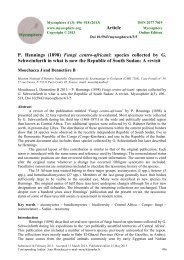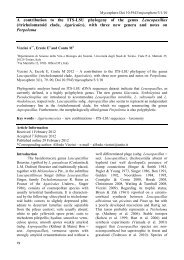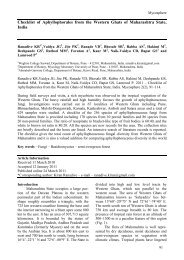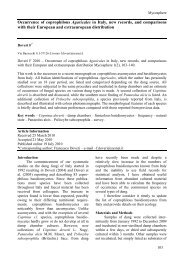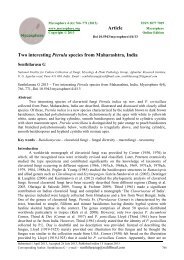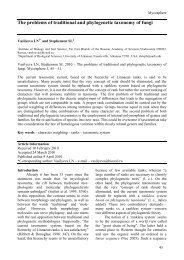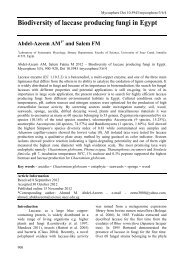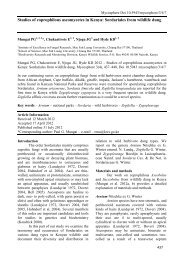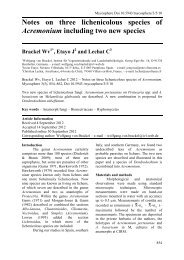The genus Inonotus and its related species in India Article
The genus Inonotus and its related species in India Article
The genus Inonotus and its related species in India Article
Create successful ePaper yourself
Turn your PDF publications into a flip-book with our unique Google optimized e-Paper software.
none; basidia clavate, 4-sterigmate, 16–22 × 5–6 μm; spores yellowish brown, thick-walled, ovoid<br />
to ellipsoid, IKI- ,CB-, (6.7–)7–10(–10.3) × (4.1–)4.5-6(–6.2 ) μm, L = 8.72 µm, W = 5.32 µm, Q =<br />
1.55–1.65, (n = 25/1).<br />
Specimens exam<strong>in</strong>ed – INDIA, Tamil Nadu, Coimbatore, Annakutti, on a fallen trunk of<br />
Acacia, 28 Nov. 2012, J.R. Sharma, JRS 1407 (BSD); ibid, Koller, on a dead st<strong>and</strong><strong>in</strong>g trunk of<br />
Prosopis, 30 Nov. 2012, J.R. Sharma, JRS 1481 (BSD); ibid, Uttrakh<strong>and</strong>, Dehradun, Rajaji<br />
National Park, On dead trunk of Acacia, 21 Sept. 2011, J.R. Sharma, JRS 718 (BSD).<br />
Remarks – This <strong>species</strong> has been repeatedly found grow<strong>in</strong>g on dead woods of Acacia <strong>and</strong><br />
Prosopis. Inocutis texanus differs from closely <strong>related</strong> I. dryophilus <strong>in</strong> hav<strong>in</strong>g larger basidiocarps,<br />
dist<strong>in</strong>ctive rimose scaly nature of upper surface <strong>and</strong> <strong>its</strong> host relationships.<br />
<strong>Inonotus</strong> P. Karst., Meddn Soc. Faunna Flora fenn. 5: 39, 1879<br />
Basidiocarps annual to rarely perennial, resup<strong>in</strong>ate, effused-reflexed or pileate, sessile to<br />
rarely stipitate, solitary to imbricate, corky fleshy to woody hard <strong>and</strong> brittle on dry<strong>in</strong>g; pileus small<br />
to medium sized, dimidiate, applanate to conchate; upper surface glabrous, tomentose to hispid,<br />
yellowish to dark reddish brown, usually without a crust, hymenophore poroid; pore surface brown,<br />
pores 2–10 per mm; context rusty to c<strong>in</strong>namon brown, mycelial core absent; hyphal system<br />
monomitic, generative hyphae yellowish to brownish, simple septate; setal hyphae present or<br />
absent; hymenial or tramal setae present or absent; cystidia none; spores globose to ellipsoid, rarely<br />
cyl<strong>in</strong>drical, smooth, hyal<strong>in</strong>e to yellowish or brown; on dead <strong>and</strong> liv<strong>in</strong>g hardwoods or coniferous<br />
woods, caus<strong>in</strong>g a white rot.<br />
<strong>The</strong> <strong>genus</strong> is easy to recognize by <strong>its</strong> annual basidiocarps with a fibrous to soft or fragile<br />
consistency. <strong>The</strong> hyphae are monomitic <strong>and</strong> generally are wider than those of Phell<strong>in</strong>us which<br />
usually has woody, perennial basidiocarps with dimitic hyphal system.<br />
Type <strong>species</strong> – <strong>Inonotus</strong> hispidus (Bull.: Fr.) P. Karst.<br />
Provisional key to the <strong>India</strong>n <strong>species</strong> of <strong>Inonotus</strong><br />
1. Setal hyphae present………………………………………………………………………………2<br />
1. Setal hyphae absent………………………………………………………………………………..6<br />
2. Ptychogastric anamorph with abundant chamydospores commonly produced…………….I. rickii<br />
2. Ptychogastric anamorph absent……………………………………………………………………3<br />
3. Branched setal hyphae present on pilear surface……………………………………...I. cuticularis<br />
3. Branched setal hyphae absent on pilear surface…………………………………………………..4<br />
4. Setal hyphae present only <strong>in</strong> dissepiments………………………………………….I. patouillardii<br />
4. Setal hyphae present both <strong>in</strong> context <strong>and</strong> dissepiments…………………………………………...5<br />
5. Basidiocarps effused-reflexed to pileate; spores 5–7 × 4–5.5 µm; context not<br />
duplex…………………………………………………………………………………...I. glomeratus<br />
5. Basidiocarps applanate with a attenuated base; spores 7.5–9 × 5.5–7 µm; context<br />
duplex…………………………………………………………………………………...I. ochroporus<br />
6. Hymenial setae present……………………………………………………………………………7<br />
6. Hymenial setae absent……………………………………………………………………………11<br />
7. Hymenial setae hooked……………………………………………………………………………8<br />
7. Hymenial setae straight……………………………………………………………………………9<br />
8. Pores 4–6 per mm; spores 5–7.5 × 4–5.5 µm; marg<strong>in</strong> not bright yellow…………...I. hamusetulus<br />
8. Pores 6–8 per mm; spores 4–4.5 × 3.5µm; marg<strong>in</strong> bright yellow……………………….I. radiatus<br />
9. Basidiocarps resup<strong>in</strong>ate; develop<strong>in</strong>g beneath bark or sapwood………………………...I. obliquus<br />
9. Basidiocarps sessile or effused-reflexed; not develop<strong>in</strong>g as above……………………………...10<br />
10. Pilear surface strongly hispid <strong>and</strong> rema<strong>in</strong><strong>in</strong>g more or less so at maturity; setae not with lateral<br />
projections; spores 8–11 × 6–8 µm…………………………………………………….I. hispidus<br />
10. Pilear surface tomentose to glabrous at maturity, delimited on upper surface by a th<strong>in</strong> black<br />
crust; setae ventricose with lateral projections; spores 5.5–7.5 × 4.5–5.5 µm….I. diverticuloseta<br />
11. Spores 8 µm or longer…………………………………………………………………………..12<br />
812



